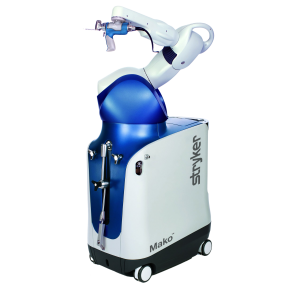Hip, Knee & Shoulder Replacement
At Midwest Bone and Joint, we are proud to provide you with
physicians that are hip, knee & shoulder replacement experts.
Dr. Felix Ungacta and Dr. Matthew Bradley are skilled in partial joint replacement, total joint replacement, outpatient joint replacement and complex revision surgeries. Together they have treated many patients with hip and knee arthritis as well as related conditions and provide the most advanced joint replacement techniques.
Hip Replacement
With recent advancements in hip replacement surgery, Midwest Bone & Joint offers patients state-of-the-art treatments for hip joint pain with disability, regardless of age. We use these advancements for joint replacement patients, to tailor the surgery for each patient’s individual needs, and to recreate natural hip movement. We are committed to ensuring that a patient’s surgery and recovery are successful. Our goal is improved quality of care, stellar outcomes and patient’s satisfaction above all else.
What is a Hip Replacement?
A Hip Replacement is a surgical procedure to remove the diseased hip joint and replace it with artificial, anatomically-correct parts called prosthesis. This is done to dramatically reduce or eliminate pain and improve function, ultimately improving the quality of life for patients that are suffering from hip arthritis, hip pain, decreased mobility, and poor quality of life.


Who Should Consider Hip Replacement Surgery?
People who have advanced hip arthritis or suffer from hip joint pain and damage that hinders daily activities, and for which other treatments have been exhausted, should consider hip replacement surgery. When the hip has a lot of “wear and tear,” it is called osteoarthritis and typically develops in the weight bearing joints of people age 50 and older.
Non-Surgical Alternatives to Hip Replacement Surgery
Before considering total hip replacement surgery, the orthopedic surgeons at Midwest Bone & Joint, may recommend an exercise program, walking aids, and oral and topical medications for pain. These solutions may improve muscle strength and support to relieve some of the pain and allow a patient to avoid or delay surgery.
Surgical Hip Replacement Options
Osteotomy – is a surgical procedure that is not as complex as a full hip replacement. It is designed to preserve the hip joint and has a purpose of reshaping either the socket or the ball when the hip socket is not in the correct position or the joint is the wrong shape. This is done is to decrease cartilage wear and tear in an attempt to delay the need for hip replacement.
Arthroscopy – is designed to repair torn cartilage and remove bone spurs that happen in the earliest stages of arthritis. Revision surgery is performed to replace a prosthesis that no longer functions well due to deterioration of the implant or the bone in which the implant is placed.
Minimally Invasive Total Hip Replacement – Standard hip replacement surgery requires a single, long incision to view and access the joint. In a minimally invasive procedure, one or two short incisions are used. Shorter incisions offer less pain and a speedier recovery.
In standard hip replacement surgery, damaged bone and cartilage are removed, leaving healthy parts of the joint intact. The muscles are split or detached from the hip, dislocating the hip for full view. The damaged head of the femur is removed and replaced with a metal stem, as well as a metal or ceramic ball that is used to replace the damaged femoral head. The surgeon removes damaged cartilage on the surface of the joint and replaces it with a metal socket lined with plastic or ceramic. The new joint components can be cemented in place, or uncemented to hold the socket in the correct position. Uncemented components are made with a porous surface which is designed to allow for biological fixation where the healthy bone grows into the pores to hold the parts in place.
In minimally invasive hip replacements the procedure is similar but there is not a need to cut the surrounding hip tissues and muscle. The same implants are used but the technique requires special surgical expertise and innovative instruments in order to repair and replace the joint. While the muscles are split or detached, they are repaired after the implants are in place. This promotes healing, prevents hip dislocations, and offers a less painful recovery and quicker return to day to day life.
At Midwest Bone & Joint, our surgeons are experts utilize MAKO® Robotic Orthopedic Surgery, an innovative technique that has been proven to significantly decrease post-op pain and blood loss, speeding up recovery time.

MAKO – is a robotic arm capable of performing MAKOplasty® total hip replacement. Each surgery is customized for each patient’s individual needs. Our goal is improved quality of care, stellar outcomes and patient’s satisfaction above all else.
Both procedures are performed under either general, spinal or epidural anesthesia. Minimally invasive surgery requires less surgical time, there is less bleeding and a shorter recovery time.
Knee Replacement
At Midwest Bone & Joint, Dr. Felix Ungacta is a knee replacement specialists. He has many patients with knee arthritis and related conditions and are specialists in the most advanced joint replacement techniques.
Knee replacement surgery is one of the most successful procedures and is a reliable, safe and effective treatment for osteoarthritis of the knee that causes knee pain and disability. It has revolutionized the quality of life for millions of patients, is proven to be cost-effective, and over 90% of patients find dramatic pain relief after this procedure. Knee replacements deliver years of health and activity to a patient’s life.
Minimally invasive knee surgery achieves a painless and durable result due to significant evolution in prosthetic design, material science and instrumentation.
What is Knee Replacement?
Knee Replacement is surgery to treat knees that have been severely damaged by arthritis, to relieve pain, and to restore mobility and quality of life. It involves the removal of damaged and diseased bone and cartilage from the thigh bone, the shin bone and the knee cap, which is replaced with an artificial joint made of metal, plastic and polymers.
Total knee replacement surgery is performed when the knee is worn on all sides of the joint. Partial knee replacement surgery is performed if only one side of the knee is arthritic and causes disability. If there is bone on bone disease, a partial knee replacement can replace the worn-out parts.


Who should consider knee replacement surgery?
When knee pain is so severe that a patient cannot sleep at night, or the pain prevents the patient from comfortably carrying out daily activities, and the knee has not improved with nonsurgical treatments, a knee replacement is an appropriate solution.
The best candidates for partial knee replacements are patients who do not lead an overly active life, have good range of motion and stable knee ligaments.
At Midwest Bone & Joint, our surgeons are experts utilize MAKO® Robotic Orthopedic Surgery, an innovative technique that has been proven to significantly decrease post-op pain and blood loss, speeding up recovery time.
MAKO is a robotic arm capable of performing MAKOplasty® partial knee resurfacing and total knee replacements. Each surgery is customized for each patient’s individual needs. Our goal is improved quality of care, stellar outcomes and patient’s satisfaction above all else.
Shoulder Replacement
Shoulder replacement surgery is a safe and effective procedure to restore comfort and eliminate motion restrictions and disability. Recovery from a shoulder replacement requires the patient’s commitment to proper and extensive post-op rehab to achieve the full benefits from surgery. Generally, surgery is recommended when people with severe shoulder pain cannot control their pain with oral medication, injections, rest and adjustment of shoulder activity.
People who would benefit from shoulder replacement surgery are those who have severe shoulder pain that interferes with every day activities that have not improved through non-surgical options. X-rays are used to determine the condition of the joint. A CT scan or MRI may be recommended to evaluate bone quality, and the condition of the soft tissue including the rotator cuff. If nerve damage is suspected, a Nerve Conduction test will evaluate the nerves that control the shoulder muscles.
What is Shoulder Replacement?
Total Shoulder Replacement replaces the damaged ends of the upper arm bone and the shoulder bone with metal and plastic parts. The parts may be cemented or press-fit into the bone. Good quality bone is necessary for the press-fit implants. The front rotator cuff tendon is released or moved with a small piece of bone for access. The arthritic parts of the shoulder ball and socket are removed. A new implant will be placed for the socket and ball. The rotator cuff tendon and tendon with the bone are repaired back together and the incision is cleaned, and bandaged.
The goal of a total shoulder replacement is to provide pain relief as well as to restore motion, strength and function. This is an open surgical procedure with a small incision along the front of the shoulder and the upper arm.
A reverse technique offers stability and does not rely on the tendons. The deltoid muscle is used to move the shoulder instead of the rotator cuff. Thus, this approach is perfect when the damaged shoulder needs new surfaces, but there is not enough healthy tissue to stabilize and move the shoulder.


Outpatient Minimally Invasive Shoulder Replacement
This is a procedure that provides total shoulder replacement as an outpatient procedure. Only short incisions are needed, and there is no moving or cutting of the rotator cuff and muscles. Because there is no damage to the rotator cuff, there are no activity restrictions and recovery is faster. This decreases costs, decreased risk of infection, less blood loss, minimal damage to soft tissues, less pain, fewer complications, reduced recovery time and faster return to recreational activities.
Shoulder Resurfacing
Shoulder Resurfacing only replaces the surface of the head of the arm bone for improved mobility. The original socket is maintained. This is often used for young active patients and avoids complete removal and replacement of the humorous head.
